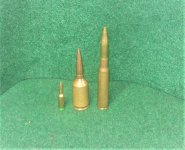coyotechet
Chet
I did a lot of checking of the last three barrels, 1 Hart 5groove 6ppc, 1 Krieger 6Dasher, 1 Proof Research 6x47.
First setup was indicating throat then very breech end of each barrel. Then checked the indicator runout at ½ inch or so in front of the indicated throat.
Second setup was indicating throat then muzzle of each barrel. Then checked the indicator runout at ½ inch or so in front of the indicated throat.
The Hart and Krieger where chambered with the Throat and muzzle setup. The Proof Research Throat and breech set up.
Each time I checked in front of the throat I could not see any differences in the indicator reading between the two setups.
After chambering each of the above three barrels I checked the runout on the free bore, shoulder and at the end of the chamber.
All three barrels indicated zero using Interapid 312-15 indicator (same amount of needle movement if any)
I used the Grizzly rod to first indicate the throat on each setup than double checked the throat with the 312-15 also at the ½ mark. I have found for myself that using the Grizzly rod first REALLY speeds up my time indicating the throat and at ½ inch or so in front.
Chet
First setup was indicating throat then very breech end of each barrel. Then checked the indicator runout at ½ inch or so in front of the indicated throat.
Second setup was indicating throat then muzzle of each barrel. Then checked the indicator runout at ½ inch or so in front of the indicated throat.
The Hart and Krieger where chambered with the Throat and muzzle setup. The Proof Research Throat and breech set up.
Each time I checked in front of the throat I could not see any differences in the indicator reading between the two setups.
After chambering each of the above three barrels I checked the runout on the free bore, shoulder and at the end of the chamber.
All three barrels indicated zero using Interapid 312-15 indicator (same amount of needle movement if any)
I used the Grizzly rod to first indicate the throat on each setup than double checked the throat with the 312-15 also at the ½ mark. I have found for myself that using the Grizzly rod first REALLY speeds up my time indicating the throat and at ½ inch or so in front.
Chet
Last edited:


